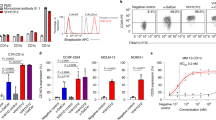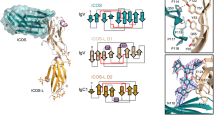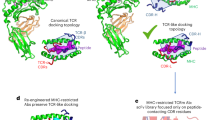Abstract
CD8 molecules function as co-receptors on cytotoxic T lymphocytes (CTLs), interacting with a nonpolymorphic region of the major histocompatibility complex (MHC) class I a3 domain on antigen-presenting cells. Analogues were designed from a structural model of the mouse CD8α molecule to identify surfaces involved in CD8 function. Peptides were screened for in vitro biological activity on alloreactive CTLs, and analogue SC4 (p54–59) was found to be inhibitory during both the generation and effector stages. SC4 was also able to significantly prolong skin al log raft survival across a MHC class I barrier. Thus, such CD8αnalogues may have therapeutic potential as immunoregulators of CTL immune responses.
This is a preview of subscription content, access via your institution
Access options
Subscribe to this journal
Receive 12 print issues and online access
$209.00 per year
only $17.42 per issue
Buy this article
- Purchase on Springer Link
- Instant access to full article PDF
Prices may be subject to local taxes which are calculated during checkout
Similar content being viewed by others
References
Doherty, P.C. T cells and viral infections. Br. Med. Bull. 41, 7–14 (1985).
Tanaka, K., Yoshioka, T., Bieberich, C. & Jay, C. Role of the major histocompatibility complex class I antigens in tumor growth and metastasis. Annu. Rev. Immunol. 6, 359–380 (1988).
Mason, D.W. & Morris, P.J. Effector mechanisms in allograft rejection. Annu. Rev. Immunol. 4, 119–145 (1986).
Zinkernagel, R.M. & Doherty, P.C. H-2 compatibility requirement for T-cell-medi-ated lysis of target cells infected with lymphocytic choriomeningitis virus: Different cytotoxic T-cell specificities are associated with structures coded for in H-2K or H-2D. J. Exp. Med. 141, 1427–1436 (1975).
Miceli, M.C. & Parnes, J.R. Role of CD4 and CD8 in T cell activation and differentiation. Adv. Immunol. 53, 59–122 (1993).
Norment, A.M., Salter, R.D., Parham, P., Engelhard, V.H. & Littman, D.R. Cell-cell adhesion mediated by CD8αnd MHC class I molecules. Nature 336, 79–81 (1988).
Salter, R.D. et al. A binding site for the T-celi co-receptor CD8 on the alpha 3 domain of HLA-A2. Nature 345, 41–46 (1990).
Veillette, A., Bookman, M.A., Horak, E.M. & Bolen, J.B. The CD4 and CD8 T cell surface antigens are associated with the internal membrane tyrosine-protein kinase p56lck . Cell 55, 301–308 (1988).
Zamoyska, R. et al. Inability of CD8αlpha polypeptides to associate with p56lck correlates with impaired function in vitro and lack of expression in vivo . Nature 342, 278–281 (1989).
Parnes, J.R. Molecular biology and function of CD4 and CD8. Immunol. 44, 265–305 (1989).
Hunkapiller, T. & Hood, L. Diversity of the immunoglobulin gene superfamily. Adv. Immunol. 44, 1–63(1989).
Williams, A.F. & Barclay, A.N. The immunoglobulin superfamily—domains for cell surface recognition. Ann. Rev. Immunol. 6, 381–405 (1988).
Sukhatme, V.P., Sizer, K.C., Vollmer, A.C., Hunkapiller, T. & Parnes, J.R. The T cell differentiation antigen Leu-2/T8 is homologous to immunoglobulin and T cell receptor variable regions. Cell 40, 591–597 (1985).
Nakauchi, H. et al. Molecular cloning of Lyt-2, a membrane glycoprotein marking a subset of mouse T lymphocytes: molecular homology to its human counterpart, Leu-2/T8, and to immunoglobulin variable regions. Proc. Natl. Acad. Sci. USA 82, 5126–5130(1985).
Leahy, D.J., Axel, R. & Hendrickson, W.A. Crystal structure of a soluble form of the human T cell co-receptor CD8αt 2. 6 Å resolution. Cell 68, 1145–1162 (1992).
Jameson, B.A., McDonnell, J.M., Marini, J.C. & Korngold, R. A rationally designed CD4 analogue inhibits experimental allergic encephalomyelitis. Nature 368, 744–746 (1994).
Jameson, B.A. Modelling in peptide design. Nature 341, 465–466 (1989).
Sanders, S.K., Fox, R.O. & Kavathas, P. Mutations in CD8 that affect interactions with HLA class I and monoclonal anti-CD8αntibodies. J. Exp. Med. 174, 371–379 (1991).
Franco, M.D. et al. Regions of the CD8 molecule involved in the regulation of CD2-mediated activation. Cell. Immunol. 157, 341–352 (1994).
Giblin, P.A., Leahy D.J., Mennone, J. & Kavathas, P.B. The role of charge and multiple faces of the CD8 alpha/alpha homodimer in binding to major histocompati-bility complex class I molecules: Support for a bivalent model. Proc. Natl. Acad. Sci. USA 91, 1716–1720 (1994).
Clayberger, C., Lyu, S.C., DeKruyff, R., Parham, P. & Krensky,, A.M. Peptides corresponding to the CD8αnd CD4 binding domains of HLA molecules block T lymphocyte immune responses in vitro. Immunol. 153, 946–951 (1994).
Emmrich, F., Strittmatter, U. & Eichmann, K. Synergism in the activation of human CD8 T cells by cross-linking the T-cell receptor complex with the CDS differentiation antigen. Proc. Natl. Acad. Sci. USA 83, 8298–8302 (1986).
Gao, G.F., et al. Crystal structure of the complex between human CD8αoc and HLA-A2. Nature 387, 630–634 (1997).
Fung-Leung, W.P., et al. The lack of CD8αlpha cytoplasmic domain resulted in a dramatic decrease in efficiency in thymic maturation but only a moderate reduction in cytotoxic function of CD8+ T lymphocytes. Eur J. Immunol. 23, 2834–2840 (1994).
Eichmann, K. et al. Affinity enhancement and transmembrane signaling are associated with distinct epitopes on the CD8αlpha beta heterodimer. J. Immunol. 147, 2075–2081 (1991).
Connolly, J.M., Hansen, T.H., Ingold, A.L. & Potter, T.A. Recognition by CD8 on cy-totoxic T lymphocytes is ablated by several substitutions in the class I alpha 3 domain: CD8αnd the T-cell receptor recognize the same class I molecule. Proc. Natl. Acad. Sci. USA 87, 2137–2141 (1990).
Mescher, M.F. Molecular interactions in the activation of effector and precursor cytotoxic T lymphocytes. Immunol. Rev. 146, 177–210 (1995).
Cai, Z. & Sprent, J. Resting and activated T cells display different requirements for CD8 molecules. J. Exp. Med. 179, 2005–2015 (1994).
O'Rourke, A.M. & Mescher, M.F. Signals for activation of CD8-dependent adhesion and costimulation in CTLs. J. Immunol. 152, 4358–4367 (1994).
Zamoyska, R., Vollmer, A.C., Sizer, K.C., Liaw, C.W. & Parnes, J.R., Lyt-2 polypeptides arise from a single gene by alternative splicing patterns of mRNA. Cell 43, 153–163 (1985).
Karplus, M. & Petsko, G.A. Molecular dynamics simulations in biology. Nature 347, 631–639 (1989).
McDonnell, J.M., Blank,, K.J., Rao,, P.E. & Jameson,, B.A. Direct involvement of the CDR3-like domain of CD4 in T helper cell activation. J. Immunol. 149, 1626–1630 (1992).
Bailey, D.W. & Usama,, B. A. rapid method of grafting skin on tails of mice. Transplant. Bull. 7, 424–425 (1960).
Sprent, J., Schaefer, M., Lo, D. & Korngold, R. Properties of purified T cell subsets In vivo responses to class I vs. class II H-2 differences. J. Exp. Med. 163, 998–1011 (1986).
Kraulis, P.J. MOLSCRIPT: A program to produce both detailed and schematic plots of protein structures. J. Appl. Crystallogr. 24, 946–950 (1991).
Author information
Authors and Affiliations
Rights and permissions
About this article
Cite this article
Choksi, S., Jameson, B. & Korngold, R. A structure-based approach to designing synthetic CD8α peptides that can inhibit cytotoxic T-lymphocyte responses. Nat Med 4, 309–314 (1998). https://doi.org/10.1038/nm0398-309
Received:
Accepted:
Issue Date:
DOI: https://doi.org/10.1038/nm0398-309
This article is cited by
-
Antagonism of cytotoxic T-lymphocyte activation by soluble CD8
Nature Medicine (1999)



